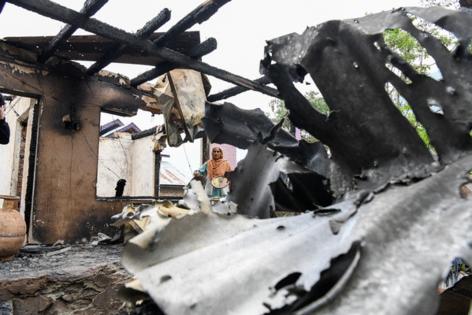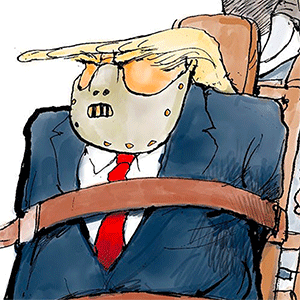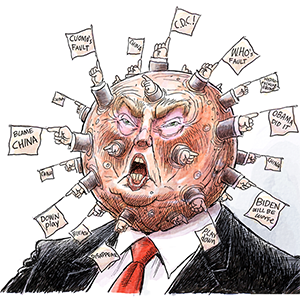Pakistan hails role of Chinese jets in repelling India strikes
Published in News & Features
Pakistan said Chinese fighter jets were used to respond to military strikes by India and that it has kept Beijing fully informed of its action as tensions in the disputed Kashmir region escalate.
Foreign Minister Ishaq Dar told parliament late Wednesday that Chinese J-10C jets were used to shoot down five Indian fighter jets along the border, including French-made Rafale jets, the Associated Press of Pakistan news service cited him as saying. India’s government hasn’t officially confirmed whether aircraft it deployed in the military strike in the early hours of Wednesday morning were destroyed.
Dar said it kept Beijing informed about the military action soon after the strikes began, with China’s Ambassador Jiang Zaidong visiting Pakistan’s Foreign Office at 4 a.m. local time on Wednesday.
Hostilities between India and Pakistan — nuclear-armed rivals who have clashed several times over the disputed region of Kashmir — have escalated since an April 22 attack that killed 26 civilians in the Indian-controlled part of the territory. India said the attack was an act of terrorism and blamed Pakistan for involvement. Pakistan has denied the claims.
India conducted military strikes against nine targets in Pakistan early Wednesday that New Delhi said were “precise and restrained” and designed to be “non-escalatory in nature.” The strikes were the deepest breach of Pakistani territory since the 1971 war. Pakistan’s army said 31 civilians were killed in the strikes, while Prime Minister Shehbaz Sharif signaled Wednesday the country would retaliate.
Pakistan’s army said Wednesday it shot down Indian jets, including three Rafales, a MiG-29, and an SU-30, without providing evidence. At a New Delhi briefing, Indian Foreign Secretary Vikram Misri detailed the April militant attack and investigation but didn’t address Pakistan’s claim.
“India will have incentives to underplay the damage, but Pakistan playing up the damage here can mitigate incentives to escalate in turn,” Ankit Panda, a senior fellow at the Carnegie Endowment on International Peace, wrote in a social media post.
Panda said, with the proviso that much can change, “Pakistan will be compelled to retaliate with parity,” adding this could include strikes against nine targets in its rival.
China reiterated Thursday its call for India and Pakistan not to escalate the situation. When asked about the use of the Chinese-made jets and the early-hours visit by the Chinese ambassador to Pakistan’s foreign office, a spokesman for China’s Ministry of Foreign Affairs said “I’m not familiar with the matter you mentioned.”
China is a major backer of Pakistan and its biggest supplier of weapons. Some 82% of Pakistan’s arms imports from 2019-2023 came from China, according to data from the Stockholm International Peace Research Institute, which tracks global arms flows.
Pakistan’s claim that it shot down the Indian warplanes was a trending topic on China’s X-like Weibo, with some Chinese users celebrating the country’s military strength. One top comment said if the news was accurate, “All of China’s major military-industrial enterprises will have orders queuing up.”
Hu Xijin, the ex-editor-in-chief of the nationalist tabloid Global Times, wrote on WeChat that if Pakistan’s successful strikes were true, it shows “China’s level of military manufacturing has completely surpassed that of Russia and France,” and that Taiwan should feel “even more scared.”
Shares of Chinese defense-manufacturing companies rallied Wednesday. AVIC Chengdu Aircraft Co., the maker of the J-10C jet, saw its shares soar by the 20% daily limit on Thursday following a 17% gain Wednesday, its biggest two-day rally in more than two years.
The India-Pakistan conflict, if it escalates, could also see largely unproven Chinese weapons being field-tested, which could address concerns about their combat capability, Bloomberg Intelligence analysts wrote in a note.
Russia and China have been the traditional suppliers of weapons to the South Asian countries and the flare-up in tensions comes as Chinese President Xi Jinping went to Moscow to join in events to mark the 80th anniversary of the end of World War II fighting in Europe. Xi is due to have talks with President Vladimir Putin on Thursday.
President Donald Trump on Wednesday called the India-Pakistan conflict “so terrible” and that we wanted the two nations to “work it out.”
“They’ve gone tit-for-tat, so hopefully they can stop now,” Trump said in reply to a question during a White House event. “We get along with both the countries very well, good relationships with both, and I want to see it stop. And if I can do anything to help, I will be there.”
The last time the two sides came close to an all-out war was in 2019, after a suicide bomber killed 40 members of India’s security forces. India blamed Pakistan and responded about two weeks later with its first airstrikes on Pakistani soil since 1971. Pakistan retaliated by shooting down an Indian jet and arresting the pilot, who was later released. Tensions died down soon afterward.
While militarily both countries have the ability to inflict untold damage, in economic terms India increasingly has much more at stake. India’s surging gross domestic product is now more than eight times the size of Pakistan’s, according to the World Bank, a gap that has roughly doubled since the turn of the century.
Pakistan, meanwhile, is only just beginning to emerge from a years-long economic crisis that brought it to the brink of bankruptcy, and is relying on a $7 billion loan program from the International Monetary Fund.
--------
—With assistance from Dan Strumpf, Sudhi Ranjan Sen, Kamran Haider, Debjit Chakraborty and James Mayger.
©2025 Bloomberg L.P. Visit bloomberg.com. Distributed by Tribune Content Agency, LLC.







Comments